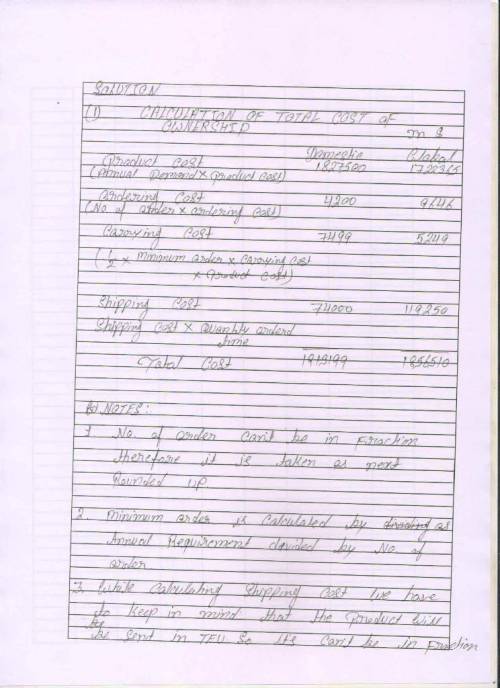Tco case study distribution example 2015 version 1.2 you work for idc distributions llc.
...

Business, 22.11.2019 06:31 gjvyverman
Tco case study distribution example 2015 version 1.2 you work for idc distributions llc.
you're responsible for sourcing new products. your company is launching a new product. you’ve found two possible sources – a domestic manufacturer and a manufacturer based on south korea. below are more details about each of the manufacturers.
domestic manufacturer
the domestic manufacturer, cornhusker industries (chi), is a qualified supplier. chi will produce a finished good in lincoln nebraska. from there, finished goods will be shipped via rail to your distribution center in dallas. it takes chi 10 days to make an order and then 5 days in transit to your warehouse. shipping costs are fob origin and cost $1,850 per teu (twenty-foot equivalent units). each teu can hold up to 600 units of your product. chi proposed a price of $85.00 per unit when responding to your request for proposal.
global supplier
the other possible supplier is kbm, which is a highly qualified supplier located just outside of seoul korea. kbm ships product via rail to the port of busan, which is located in mouth of the naktong river in south korea. it is the tenth biggest port in the world based on cargo throughput. when an order is placed with kbm it takes 15 days for kbm to manufacture the order and place the order in teus used for shipping. it takes one day for rail from seoul to busan. the shipment will wait 4 days in busan to be loaded on to a ship. from there it takes 16 days to cross the pacific ocean to the port of long beach, and then 3 additional days to clear customs. once the shipment clears customers, it is loaded on to rail and shipped fob origin. it arrives in dallas in 4 days. import tariffs and duties are $325 per teu. rail shipping costs are $2,250 from long beach to dallas. in the rfp, kbm’s bid was 85,477.37 korean won per unit (current exchange rate is $1=1,067 krw).
additional details
transport in the usa, whether from domestic or international suppliers, will travel via rail. the products will be in teus (twenty-foot equivalent units) for shipping and each teu can contain up to 600 units of your new product. your inventory carrying costs are 32.2%. also, each order placed costs $105 for domestic suppliers and $182 for international suppliers. the international ordering costs are higher due to the additional complexity of getting products through customs.
working with your heads of cost accounting and demand planning, you’ve done some preliminary calculations and have determined that: • safety stock required would be 432 units for the global supplier and 160 for the domestic manufacturer • average cycle stock inventory (the average non-safety stock inventory) would be 275.5 for the global supplier and 203.5 for the domestic supplier • annual demand for the new product is 21,500 units • the optimal number of orders (based on demand and eoq formula) for the global supplier is 39.2 and is 52.83 for the domestic supplier • ocean shipping costs from bosan are $1,818 per teu
questions: (1) what is the total cost of ownership for each supplier? (2) which supplier would you choose and why?

Answers: 1


Another question on Business

Business, 21.06.2019 20:20
Molander corporation is a distributor of a sun umbrella used at resort hotels. data concerning the next month’s budget appear below: selling price per unit $ 29 variable expense per unit $ 14 fixed expense per month $ 12,450 unit sales per month 980 required: 1. what is the company’s margin of safety? (do not round intermediate calculations.) 2. what is the company’s margin of safety as a percentage of its sales? (round your percentage answer to 2 decimal places (i.e. 0.1234 should be entered as 12.
Answers: 3

Business, 22.06.2019 07:30
When selecting a savings account, you should look at the following factors except annual percentage yield (apy) fees minimum balance interest thresholds taxes paid on the interest variable interest rates
Answers: 1

Business, 23.06.2019 00:00
Winston churchill's stamp collection was valued at $14 million when he died. at auction, it brought in only $4 million. what was it worth? why?
Answers: 3

Business, 23.06.2019 00:10
Kcompany estimates that overhead costs for the next year will be $4,900,000 for indirect labor and $1,000,000 for factory utilities. the company uses direct labor hours as its overhead allocation base. if 100,000 direct labor hours are planned for this next year, what is the company's plantwide overhead rate?
Answers: 3
You know the right answer?
Questions





Mathematics, 28.01.2021 19:00


History, 28.01.2021 19:00






Arts, 28.01.2021 19:00

Social Studies, 28.01.2021 19:00

Mathematics, 28.01.2021 19:00

Mathematics, 28.01.2021 19:00

Mathematics, 28.01.2021 19:00

History, 28.01.2021 19:00






